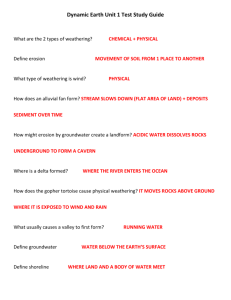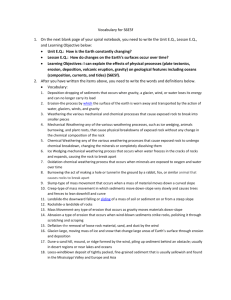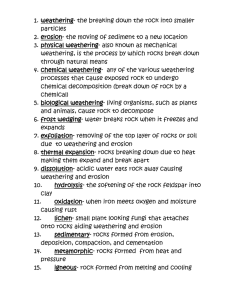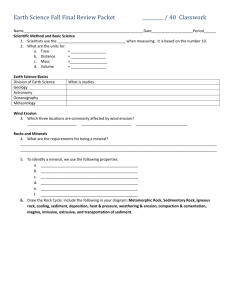ROCKS, FOSSILS AND SOILS SECTION 6: EROSION AND WEATHERING STANDARDS:
advertisement
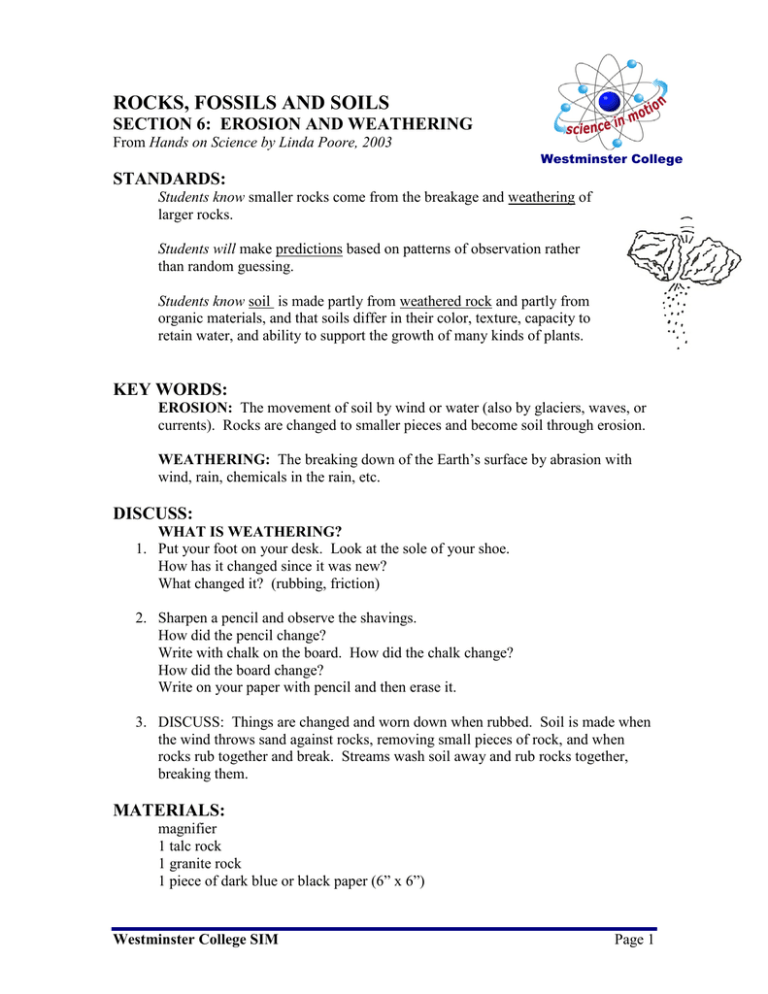
ROCKS, FOSSILS AND SOILS SECTION 6: EROSION AND WEATHERING From Hands on Science by Linda Poore, 2003 Westminster College STANDARDS: Students know smaller rocks come from the breakage and weathering of larger rocks. Students will make predictions based on patterns of observation rather than random guessing. Students know soil is made partly from weathered rock and partly from organic materials, and that soils differ in their color, texture, capacity to retain water, and ability to support the growth of many kinds of plants. KEY WORDS: EROSION: The movement of soil by wind or water (also by glaciers, waves, or currents). Rocks are changed to smaller pieces and become soil through erosion. WEATHERING: The breaking down of the Earth’s surface by abrasion with wind, rain, chemicals in the rain, etc. DISCUSS: WHAT IS WEATHERING? 1. Put your foot on your desk. Look at the sole of your shoe. How has it changed since it was new? What changed it? (rubbing, friction) 2. Sharpen a pencil and observe the shavings. How did the pencil change? Write with chalk on the board. How did the chalk change? How did the board change? Write on your paper with pencil and then erase it. 3. DISCUSS: Things are changed and worn down when rubbed. Soil is made when the wind throws sand against rocks, removing small pieces of rock, and when rocks rub together and break. Streams wash soil away and rub rocks together, breaking them. MATERIALS: magnifier 1 talc rock 1 granite rock 1 piece of dark blue or black paper (6” x 6”) Westminster College SIM Page 1 EROSION AND WEATHERING EXPLORE: WEATHERING: BIG ROCKS BECOME LITTLE ROCKS: 1. Let each team take the granite and talc rocks out of the tray. Predict – Which rock will break into smaller pieces? Tell them to rub them together over their paper for 10 seconds. (dark paper works best) 2. Call out start and then stop after 10 seconds. Let their partner do the same experiment. Collect rocks so students don’t continue destroying the talc rock. 3. Which rock was destroyed? (talc) Was it a soft or hard rock? (soft) What would happen if you kept rubbing them together? (Talc rock would be broken into tiny pieces.) 4. Feel the tiny pieces of talc. (soft) This is talcum powder, used on babies. Wind blows sand against mountains, rubbing away rock. Rocks rub together when a stream transports them. This process is called weathering. MATERIALS: 16 cups of water school sandbox DEMONSTRATE: WHAT DOES RAIN DO TO A MOUNTAIN? 1. Have students work in teams to build 2 mountains in the school sandbox. Gather students around the sandbox. (Or put wet sand in c cup and turn it upside-down on a plastic lid, making a small mountain.) 2. OBSERVING EROSION Divide the students into 2 teams. Give 8 cups of water to each team. Predict what will happen if the water is poured on the mountain. Pour water slowly on the first mountain top, 1 cup at a time. Discuss. Tell students that Erosion is the big E word. It means something is worn off and moved by water or wind. On the second mountain, have all 8 students pour the cups of water at the same time on the top of the mountain and observe erosion. Compare the results. What variable did we control? (same amount of water) (The amount of erosion varies with the force of the rain or river.) Relate this experiment to any local flooding on the news. Westminster College SIM Page 2



